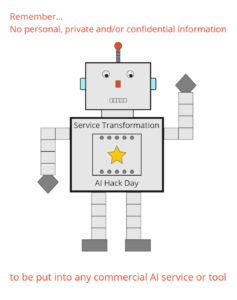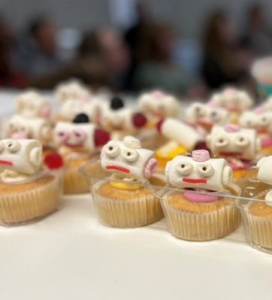We recently hosted a hackday to learn about generative AI. It was a rare and valuable opportunity for the whole Service Transformation team to take time out together and we wanted the day to be fun and free for exploring ideas.
We took an unconference approach to the day so people could steer the agenda and we set ourselves 3 simple goals:
By the end of the day, we hope to:
- learn a bit more about some AI tools and how they might help us in the public sector,
- try some things and have some learning that we can share,
- identify a few areas to take forward
We invited people from across corporate services to attend, and on the day were joined by people from Data and Analytics, Technology, Research, and Information Governance.
Preparing to get the most out of the day
Leading up to the day, there were a few things we did to help prepare so people could get the most out of this time:
- short presentations on what AI is and how we are already using AI at ECC
- sign-posting people to where they could read about AI and specifically the generative AI tools we were looking to experiment with
- shared examples of how generative AI is already being used elsewhere
- 4 simple questions to help people prepare to pitch an idea for the hack
- sign up to the tool(s) we wanted to use to save some time on the day
On the day
We welcomed our attendees with a reminder of our goals and how the day would be structured. We also gave the following guidelines:

- Data protection - don’t add any personal, private and /or confidential information into the tools that you use. Be mindful about search terms and be respectful to others
- Stay with a problem so you have something to show - you may have lots of ideas, but you’ll get more out of the day by focusing on ‘a thing’ and having something to show
- Have in mind the playback at the end of the day – this will give us a record of what we did and what we learned. ‘Post it note’ key bits of learning as you go and dedicate some time to thinking about what you want to share
- There’s lots of expertise in the room so if you run into problems ask for help
Next, we heard 2-minute pitches from everyone who had an idea. These were presented as answers to the following questions:
- What problem are you looking to solve?
- What AI tool do you want to try using to solve this problem?
- Who would this help or benefit?
- What will you need to do this?
This format worked well, and you could feel the energy in the room as people’s enthusiasm for getting started grew.
As each pitch was given it was added to a white board and if anyone had a similar idea, they were up next so we could group ideas into similar or overlapping problem spaces:
- How these tools might augment the design process, specifically looking at problem definition, analysis and synthesis, ideation and prototyping
- How these tools might help us with a selection of content tasks, assessing the effectiveness and quality of what is created
- How might we use the summarising abilities of things like ChatGPT and video/voice emulation to provide a bespoke service for people who struggle with text heavy content
- How might we use generative image tools to create story boards and visual assets?
- How might we create the governance frameworks and policy tools to safely use AI tools at ECC
- In the context of summarising meeting outputs and case histories, how to test prompting approaches and spot hallucinations
- How might we use these tools to create and pitch business cases, award submissions etc
- Can we use large learning models to interact with open data for auditing activities?
Once all the pitches had been heard and grouped, people self-organised into groups working on the problem they were most interested in or could offer the most help to.
The rest of the day was split into 3 working sessions each 75 minutes long.
Sharing what we learned

At the end of day, we had an hour-long playback where each group shared what they had learned. Groups were given 5-minutes to answer the following questions but most importantly to show us what they did:
- What problem were you looking to solve?
- How did you approach the problem / what tool(s) did you use?
- What have you learned? (Highlights and lowlights)
- What can we take forward?
And 5-minutes just wasn’t long enough! Each group had learned loads, had lots to share and there was lots of discussion. A key take-away from the day was to allow more time for playing back.
It was a great day and we learned lots more that we will share in future posts here. If you’d like to hear about the problems we worked on and the AI tools we experimented with, you can subscribe to Service Transformation updates.
The day was also a reminder of the wider benefits of spending focused time in-person to work on problems together. We came away from the day feeling energised and motivated, and we formed some new relationships with colleagues that we don’t always get the chance to work with.
Leave a comment